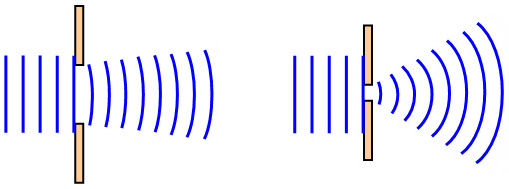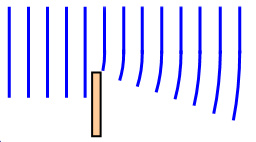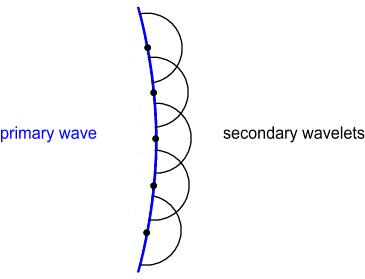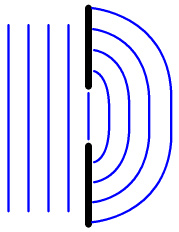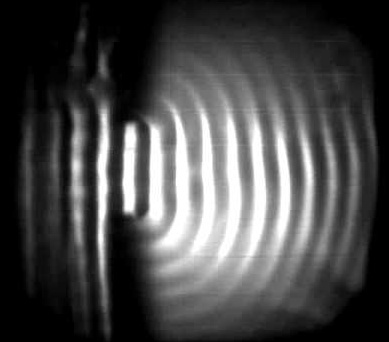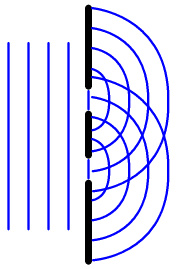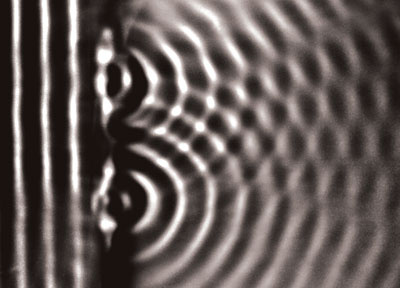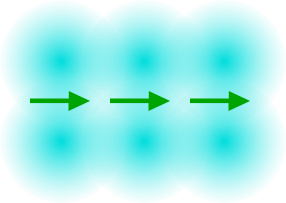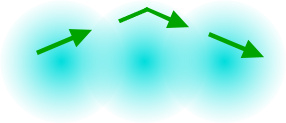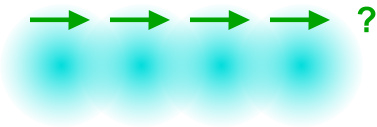Diffraction of Light
When light passes through an opening it is observed to spread out. This is known as diffraction and becomes more pronounced with narrower openings.
A similar effect also occurs when light hits an opaque edge, causing the light to bend around the edge.
The fact that this happens is to be expected. Light is known to
be a wave and waves, such as water waves and sound waves, are also known
to expand through openings.
Huygens-Fresnel principleThe explanation of how light can spread is given by the Huygens-Fresnel principle. It states that every point on a wavefront can be considered a source for another wavefront which will then become a source for further wavefronts as shown:
Here we see a spherical wavefront generating a series of wavelets. Each wavelet sits like a soap bubble atop a primary soap bubble. The side parts of the wavelets are said to combine and cancel each other, leaving behind only the front part of the wave.
Problems
This principle is used to predict what kinds of patterns will occur
when light passes through different diffraction gratings such as single
and double slits. And while nobody denies that it does a good
job of predicting, there are many problems in believing that this
represents a true model of what actually happens with light.
Here we see a primary wavefront, which generates a secondary wavelet, which generates a third/fourth/fifth, etc. Until finally we have a wave that flows backward. All light passing through empty space should diffract and spread in all directions. Instead it diffracts only when interacting with an opaque material.
The Edges
So how can diffraction work without a flexible medium, and why doesn’t
light diffract in empty space, as the Huygens-Fresnel principle would
suggest?
Here we see light passing directly through the opening and a small amount reradiated from the edges. The radiation from the edges will come out spherically and combine with the light passing straight through. As a result it will produce interference patterns on a screen.
Single slit patternsAs evidence for this idea, consider this typical interference pattern produced by light passing through a single slit:
This pattern also fits with a prediction from the Huygens-Fresnel
principle.
Since no waves crossover and interfere with each other, there’s no
reason for any interference pattern to emerge.
This was taken in a ripple tank. Plane waves come in from the
left, pass through an opening, and then emerge in a shape similar to
the previous diagram.
Double slit patternsWhat about double slits? Here’s a typical interference pattern produced by light passing through two slits:
We have what looks like a large-scale pattern overlayed with a
small-scale pattern. This again fits with a prediction from
the Huygens-Fresnel principle, but again doesn’t match a ‘normal’
wave.
When those semicircles overlap they will produce interference but the
gap between interference peaks won’t be much different to the
wavelength of the original wave.
The ‘screen’ shows only a large-scale interference pattern with no
secondary small-scale patterns on top. Given the shape of the
water emerging through the slits, there’s no conceivable way that a
secondary pattern could appear.
The pair of points belonging to each slit are close together and these are what would be responsible for the small-scale pattern within the large-scale pattern.
The details
Let’s look now into the details of how the light-bending might
occur. Earlier it was suggested that light was being absorbed
and reradiated from the edges. But this seems unlikely
because the amount of radiation would depend on how dark the material
was, with fully dark materials (zero albedo) producing almost no
diffraction – and this is not what we observe.
When the atoms are on the surface of a solid material, the fields from the electrons are going to be heavily overlapping each other on all sides but one. If the material is transparent and the light was coming from within at a low angle, this would allow the light to be internally reflected, i.e. total internal reflection.
We don’t understand how light can be reflected in that manner but
presumably it has something to do with how the fields overlap
differently at the surface.
The above diagram shows light skimming across the surface of a material.
The light is moving within the material, but though the ‘cloud’
of electrons belonging to the atoms in the top-most layer of the
material. We will assume light is able do this even if the
material is opaque as it is not actually passing though the material,
i.e. it is not passing between the nuclei in the material.
Such spherical radiation would then produce diffraction patterns if combined with other waves.
Conclusions
The way light diffracts is inconsistent with how other waveforms such
as water waves diffract. The reason why light produces
interference patterns is not due to the Huygens-Fresnel principle but
more likely has to do with how light interacts with the electric fields
of atoms on the edges of diffraction gratings. |
